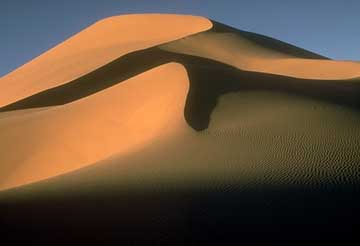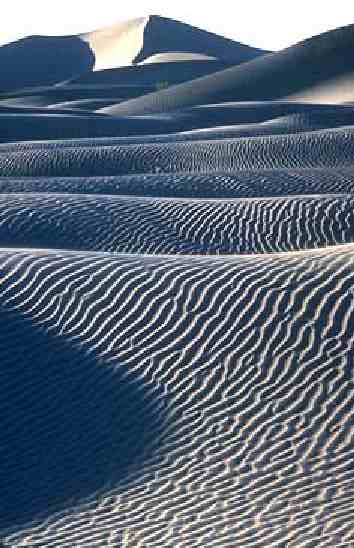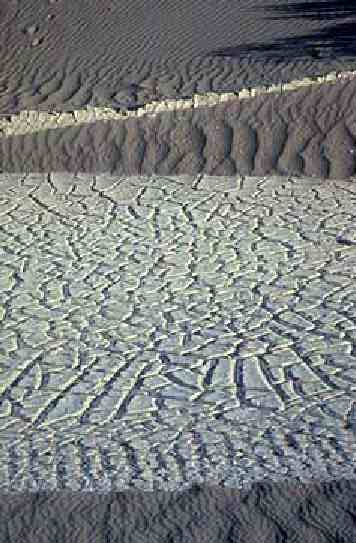
The Sand Dunes

Death Valley National Park contains several dune fields. The best known and one of the largest fields lies at Stovepipe Wells, easily accessible from either the state highway through Stovepipe Wells, or from the picnic area at its eastern edge. Other dune fields lie near Saratoga Springs in southern Death Valley, in the northern Panamint Valley, and in the southern part of Eureka Valley.
Click on either of the images to see a larger version.
 In order to form,
sand dunes require a steady supply of sand, wind to blow the sand, and
a wind break that causes deposition of sand. Each dune field in Death Valley
National Park receives most of its sand from the nearby alluvial fans and
experiences plenty of wind. Furthermore, each dune field lies in an area
that is slightly sheltered from prevailing winds. The dunes at Stovepipe
Wells, for example, lie in the embayed mountain front just north of Tucki
Mountain. The dunes in Panamint Valley lie at the far north end, well above
the main part of the valley in elevation and against the mountains, the
dunes near Saratoga Springs lie in a bowl-shaped area within the Ibex Hills,
and the dunes in the Eureka Valley lie between the Last Chance and Saline
Ranges.
In order to form,
sand dunes require a steady supply of sand, wind to blow the sand, and
a wind break that causes deposition of sand. Each dune field in Death Valley
National Park receives most of its sand from the nearby alluvial fans and
experiences plenty of wind. Furthermore, each dune field lies in an area
that is slightly sheltered from prevailing winds. The dunes at Stovepipe
Wells, for example, lie in the embayed mountain front just north of Tucki
Mountain. The dunes in Panamint Valley lie at the far north end, well above
the main part of the valley in elevation and against the mountains, the
dunes near Saratoga Springs lie in a bowl-shaped area within the Ibex Hills,
and the dunes in the Eureka Valley lie between the Last Chance and Saline
Ranges.
Dunes can be classified according to their shapes. Star dunes consist of three or more arms and generally require a variety of prevailing wind directions to form. Crescentic and linear dunes both contain two arms but differ in that crescentic dunes are asymmetrical in profile while linear dunes are symmetrical. At Stovepipe Wells, the dune field contains both star and crescentic dunes. Low, flat "interdune" areas lie between the crescentic dunes. The star dunes tend to be the higher dunes that lie near the center of the field whereas the crescentic dunes are lower and lie closer to the margins. At the far margins of the field, stands of mesquite grow atop stable conical hills of sand.
 Remnants
of a sheet-like deposit of fine-grained, mudcracked sediment occupy much
of the interdune areas at Stovepipe Wells. This deposit accumulated on
the bottom of a lake that recently covered the area now occupied by the
dunes. Presently, this deposit is being eroded in some places, and buried
by sand in others.
Remnants
of a sheet-like deposit of fine-grained, mudcracked sediment occupy much
of the interdune areas at Stovepipe Wells. This deposit accumulated on
the bottom of a lake that recently covered the area now occupied by the
dunes. Presently, this deposit is being eroded in some places, and buried
by sand in others.
Back to National Parks
Back to Death Valley